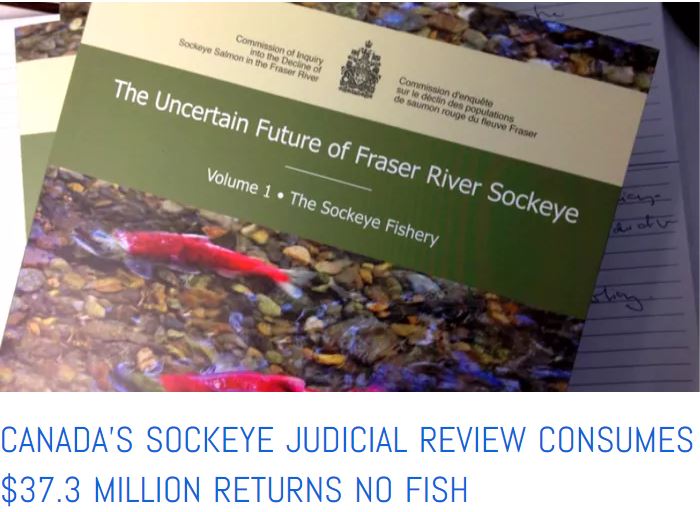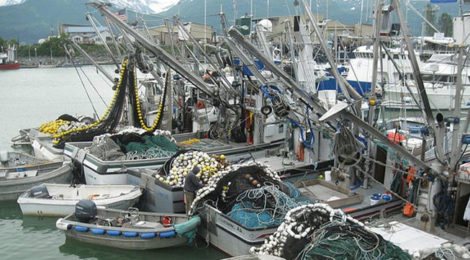
Alaska Pink Salmon Mysterious Disappearance
Historic low Pink Salmon numbers mystify Alaskan fisheries experts
But there is no mystery, the salmon join countless other marine species starving to death on ocean pastures that are becoming clear blue deserts
In 2012 I proved an ocean fish pasture in the Gulf of Alaska could be regenerated and restored to historic abundance, the following year instead of the expected 50 million Pink Salmon to be caught by Alaska fishers 226 million were caught – the largest catch in all of history. That catch brought more than $700 million into the state economy.
A battle of words has waged ever since with official salmon managers refusing to acknowledge that any effort invented, let alone delivered, outside of their tightly held cabal could possibly have anything to do with their salmon.
The salmon have something entirely different to say about this as they speak with their numbers. In 2013 my fish sent 226 million votes in favor of ocean restoration, this year barely 10% of that number of salmon remain alive.
We can and must work every year to sustain vital ocean pastures to bring back the fish and all of marine life.
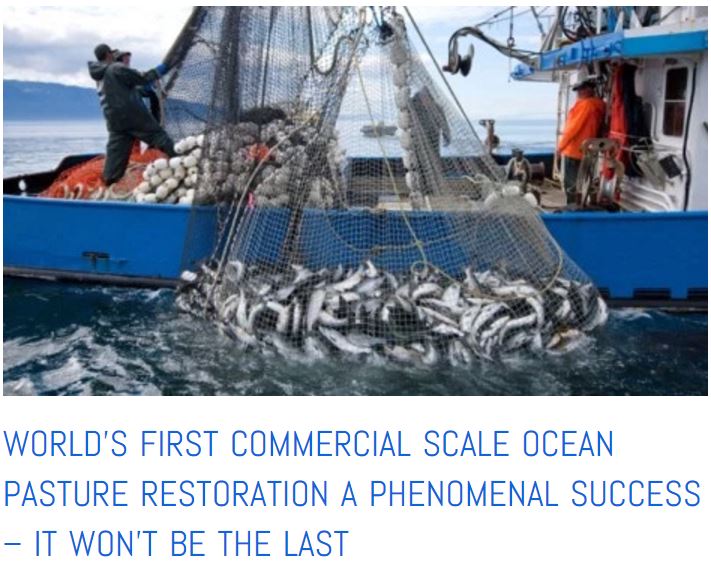
2016 Alaska catch of Pink Salmon looks to be 10% or less of the record catch of 2013 when Alaska salmon were brought to an all time high by restoration of their ocean pasture. IT JUST WORKS! – CLICK TO READ MORE
As of this date this year’s Alaskan commercial fishers have only harvested 8 million pinks as of Aug. 15 in Prince William Sound, the state’s largest pink run. The forecast for the whole state harvest is dismal to say the least, the catch is likely to be less than half of the 34 million expected, which was already accounting for expected dismal returns!
Here’s what is being said in Alaska
Dan Gray, the area management biologist for Southeast Alaska’s commercial fisheries, said
He and fishermen both are stumped as to the poor run’s nature, but seem to think the high seas survival had to be the cause. Any hope for a midseason increase is slim. The Southeast pink salmon run midpoint is always the first week of August, now well past.
“They ratio of males to female fish is way off (fewer males this year) and that generally indicates an early and possibly compressed run timing,” he said.
“Maybe it shouldn’t be, because we’ve seen such anomalies in the last couple years, with Bristol Bay being two weeks late (in 2015). If that thing was ever two days off the average peak it was big news. We’re seeing some historical really weird stuff. I ask around, ‘Have you ever seen anything like this?’ Across the board, the answer is ‘no.’ This is just historically odd.”
Charles Russell, the area management biologist for ADFG’s Cordova office, says the same thing as Gray. And its not just the Pink Salmon all the salmon are in a crisis.
— The king salmon harvest (341,000) down 42 percent from last year in net fisheries (though the troll-caught catch is strong);
— Silvers (fewer than 2 million) down 20 percent;
— Chums (12 million) down 25 percent. “We’re probably looking at the second-worst harvest in the past 10 years.”
“You used to be able to set your clock to a lot of things,” said Russell. “Now every year there seems to be a new variable introduced.”
Widespread Ocean Pasture Collapse
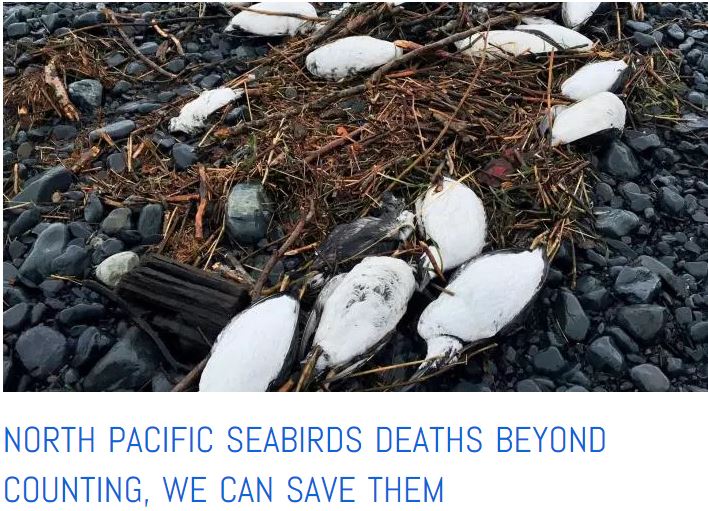
Scores of thousands of Alaskan seabirds and hundreds of great whales reported starved to death on Alaska’s beaches – click to read more
“From what I can gather, something knocked them down early,” said Russell. “As to what that variable is, it could’ve been ocean temperature or food variables, something that affected the stock across the board.”
Salmon hatcheries and habitat restoration projects in Alaska depend on their catch share of returning fish to fund their continuing operation and are now threatened by financial collapse of bad returns. The Valdez Fisheries Development Association predicted a catch of 17 million fish, but Russell said they will be lucky if they catch 8 million. That catch won’t suffice to meet their next year’s operating budget.
The Prince William Sound Aquaculture Corp. expected 20 million in total, and up to 6 million by Aug. 11. By that date, however, fishermen only caught 1.2 million so their financial future is anything but ‘in the pink.’
Hatcheries throughout the state will likely not meet their cost recovery harvest, said James Jackson ADFG biologist, further he noted fishermen on Kodiak Island, the state’s third largest pink run, “things are even crazier,” they will be dealing with an unprecedented island-wide week-long closure.
Last year, the commercial fleet harvested 33 million fish, an enormous run by Kodiak’s standards. This year, Jackson said a 4 million harvest is very optimistic. It will surely be the worst return Jackson has seen since the 1970s. Like Southeast and Prince William Sound, the run was early.
“It’s a phenomenal shift,” said Jackson. “Probably the most frightening thing is not only is this run weak but it looks like it peaked already. Usually right now we’re about 60 percent of our run timing. I wouldn’t be surprised if we’re around 80 percent of our run timing right now.”
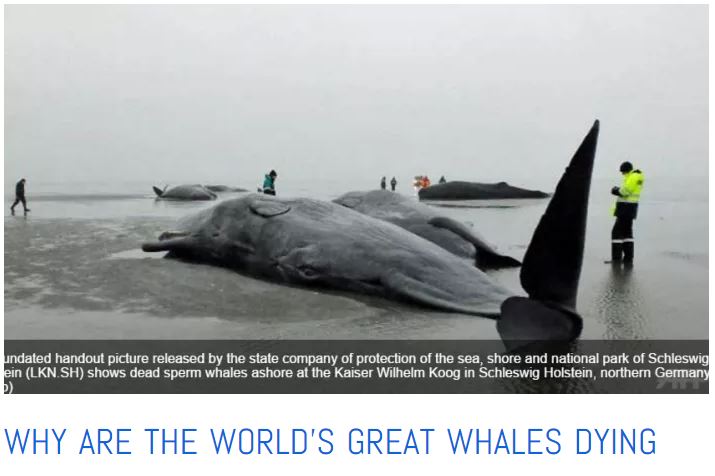
In 2015 the whale community was shocked when reports of finding 45+ Humpbacks and rarer Fin and Sei whales were found emaciated and dead along the coast of Alaska. Experts in Alaska reported normally they will see one dead great whale only once every 2-3 years! So the mass die off of great whales is unprecedented. – click to read more
Not just salmon all of Pacific Ocean life is dying.
The environmental factors carry over from last year, when Kodiak experienced a glut of sea-bird and whale mortalities. The irregularities in marine survival of some many species, he said, leads to more questions and few answers.
Another worry is that amongst the Pinks being caught there is a very unusual number of very large fish some reaching 10 pounds. One might think this to be good news but it reveals more trouble with Pinks, the most numerous of all salmon. These big fish have to be 3 year old fish which are ordinarily a tiny fraction of the Pinks of which 99% are usually 2 yrs old upon returning to spawn.
The large number of 3 yr. old fish suggests that the collapse of this years Pink run/cohort is even worse than it seems with an even larger percentage of this year’s cohort dying at sea. The future for Pink Salmon in the Gulf of Alaska is indeed now highly questionable. In general in fish and wildlife science sudden declines of this magnitude are commonly reported as being near extinction events.
If you dare here is a link to a recent global ocean death toll.
Sockeye salmon in the Fraser River of British Columbia are making an even worse showing this year.
Reports of the International Salmon Commission now state that the Fraser River Sockeye are returning in the lowest numbers in all of history, since records were started to be kept in 1893. Some few years ago when double the number being seen this year, 1.2 million, were counted in the Fraser River experts declared the fish was nearing extinction. The Canadian government responded to that unbearable number by assigning Supreme Court Justices Cohen to convene a Royal Investigative Commission to try to find out why the iconic Sockeye were in such peril and provide court instructions on how to bring the fish back.
Justice Cohen spent years in his commission and $40 million dollars commanding expert sworn testimony and delivered nothing but politically correct bureaucratic bafflegab. Justice Cohen was counselled by the salmon science & management cabal to ignore the ocean pasture life-cycle crisis of salmon where salmon spend the most important part of their lives and put on 95% of their body weight. Like all grazing wildlife the health and condition of the pasture defines the numbers of fish and wildlife that may survive and thrive.
The story of the Cohen Commission was made especially poignant by a rare natural event. While the politically correct and dutiful justice was holding court instead of the near 1 million extinction levels of Sockeye salmon expected to trickle into the Fraser River outside his courtroom 40 million Sockeye flooded the river swimming in from the Gulf of Alaska Sockeye pasture that they share with Pink Salmon.
The very real tragedy of the Cohen Commission is that the interest alone on the $40 million in legal fees paid by government would suffice to sustain NE Pacific salmon pasture restoration forever returning and sustaining Pacific salmon in Canada and Alaska forever!
How to bring back the fish!
The historically large number of Sockeye that tried to tell Justice Cohen the real story of their crisis was due to the eruption of the Alaska Aleutian Island volcano Kasatochi that dusted the salmon pasture 2 years earlier just as the Fraser sockeye babies were heading out to sea. Instead of mostly starving those young fish were treated to a feast, they grew and grew, and before too long they swam back to their Fraser River home 40 million strong. (Watch this video of a song about that Sockeye miracle.)
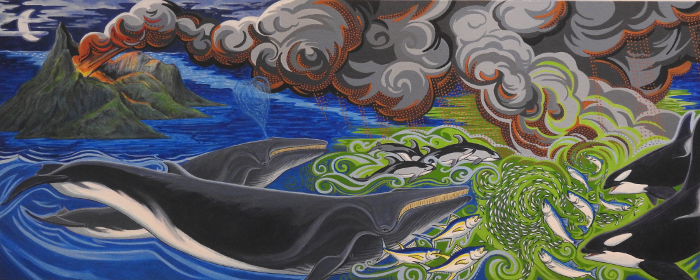
I hired artist Leanne Hodges to paint what has been long in my mind’s eye and sketch books and this fabulous painting of the Kasatochi salmon pasture miracle resulted. Two other Aleutian volcanoes in the past century have similarly sent record numbers of salmon home from thriving ocean pastures they dusted with life giving mineral rich ash. – click to read more
Some few were paying attention to and learning from the fish that year. In the summer of 2012 another volcano dusted the NE Pacific, this time it was the human volcano Russatochi. With 11 Indian friends and support of their tiny village I was astonishingly successful in my ocean pasture restoration project. The project was undertaken following years of development with Haida First Nations and Canadian federal government endorsement and science funding. IT JUST WORKED!
The time has clearly come to begin intelligent caring restoration and regeneration of vital Gulf of Alaska ocean salmon pastures to bring back the fish, the whales, the sea-birds, and all of ocean life. The cost to implement and sustain this work on a yearly basis will be but a few scant million dollars. Here’s how.
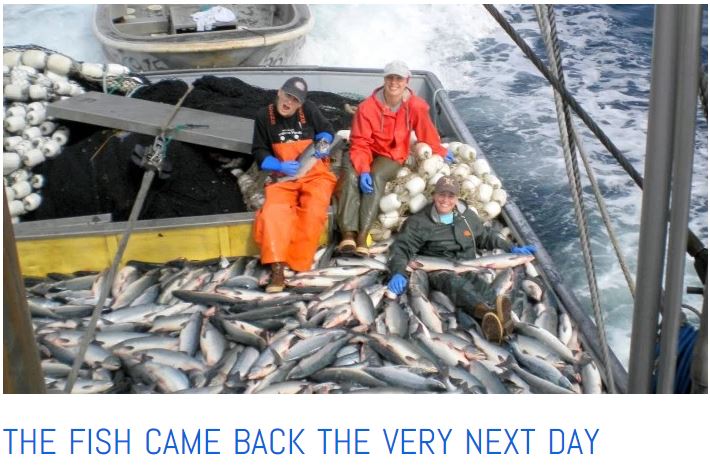
My 2012 Gulf of Alaska human volcano, ‘Russatochi’, demonstration restored 50,000 sq. km. of vital ocean salmon pasture in the heart of Alaska Pink Salmon and Fraser River Sockeye habitat. The results were clearly seen in all time historic high numbers of both fish returning right on schedule. We can and must restore ocean fish pastures.
Join me, the work to restore the world’s oceans has begun anew!









